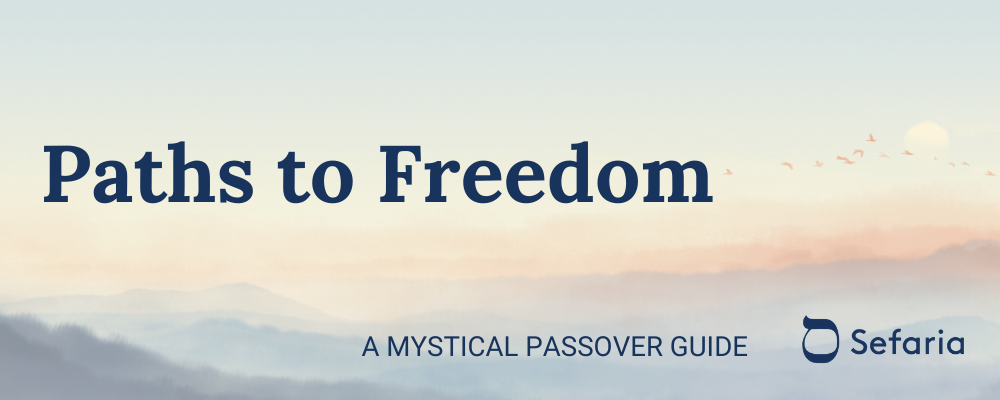
(23) And it came to pass during those many days that the king of Egypt died. And the Children of Israel sighed from their labor and they cried out. And their groaning rose up to God from their labor. (24) God heard their moaning, and God remembered God's covenant with Abraham, Isaac and Jacob. (25) God saw the Children of Israel, and God knew.
But the Zohar - a primary Kabbalistic work - offers a slightly different take on the nature of the people's initial sigh of pain. The Zohar's mystical viewpoint locates God at the center of all reality and all events of the universe - even, in the very experience of pain and suffering. Through a novel reading of the Hebrew grammar used to describe the Children of Israel's sigh, the Zohar identifies the presence and involvement of the Divine within that sigh itself.
וַיֵּאָנְחוּ בְּנֵי יִשְׂרָאֵל, וַיִּתְאַנְּחוּ לָא כְּתִיב, אֶלָּא וַיֵּאָנְחוּ, כְּלוֹמַר, נִתְאַנְּחוּ לוֹ לְמַעְלָה שֶׁהָאֲנָחָה הָיְתָה בִּשְׁבִילָם לְמַעְלָה.
...
אָמַר רִבִּי יִצְחָק, תְּלַת עִנְיָינֵי הָכָא: אֲנָחָה, שַׁוְעָה, צְעָקָה. וְכָל חַד מִתְפָּרְשָׁא מְאַחֲרָא. אֲנָחָה: כְּתִּיב, וַיֵּאָנְחוּ בְּנֵי יִשְׂרָאֵל. צְעָקָה: דִּכְתִּיב, וַיִּצְעָקוּ. שַׁוְעָה: דִּכְתִּיב, וַתַּעַל שַׁוְעָתָם. וְכָל חַד בִּלְחוֹדוֹי מִתְפָּרְשָׁא, וְכֻלְּהוּ עָבְדוּ יִשְׂרָאֵל. אָמַר רִבִּי יְהוּדָה, צְעָקָה וְשַׁוְעָה עָבְדוּ, אֲנָחָה לָא עָבְדוּ, מַשְׁמַע מִדִּכְתִּיב וַיֵּאָנְחוּ וּלְמַעְלָה הָיְתָה הָאֲנָחָה בִּשְׁבִילָם.
"And the Children of Israel sighed,"
it does not say “וַיִּתְאַנְּחוּ — they caused themselves to sigh” but rather “וַיֵּאָנְחוּ — they were sighed”, in other words they caused a sigh for [God] above, meaning that there was a sigh on High on their behalf.
....
Rabbi Yitzchak said, there are three matters here: A sigh, a groan, a scream. Each one is distinct from the other. A sigh: as it says, "and the children of Israel sighed." A scream: As it says, "and they screamed." A groan: As it says, "and their groaning rose up." Each one is distinct, and Israel did each of these. Rabbi Yehudah said, they screamed and they groaned, but they did not sigh. This is implied by what is written, "וַיֵּאָנְחוּ - and they were sighed", and the sigh was on their behalf on High.
(א) ויאנחו בני ישראל מן העבודה ויזעקו ותעל שועתם אל האלהים מן העבדה. בכאן מתחלת הישועה, כיון שהיו זועקים מיד ותעל שועתם שהתחילה הישועה, כי עד כאן לא היה בהם שום התעוררות לזעוק ולהתפלל. ומכיון שרצה השי"ת להושיעם התעורר בהם זעקה וזה הוא התחלת הישועה כשאדם מתעורר לזעוק לה'. וכמו שאמר דוד המלך ע"ה (תהלים ס"ו,כ') ברוך אלהים אשר לא הסיר תפלתי וחסדו מאתי, היינו כיון שנמצא בו תפלה מאיר השי"ת חסדו, שמקודם שרוצה השי"ת להושיע אין האדם רואה את החסרון שלו, ואינו יודע כלל מה הוא חסר לו, אבל כשהשי"ת רוצה להושיע מראה לו שורש חסרונו, וממילא יראה כי כל הסתעפות חסרונותיו הם רק משורש הזה, ושולח לו כח תפלה וצעקה להשי"ת ומתחיל להרעיש על זה להשי"ת, ואז השי"ת מאיר לו חסדו.
And the Children of Israel sighed from their labor and they cried out. And their groaning rose up to God from their labor. At this moment, the salvation began. Once they started to cry out, then immediately "their groaning rose up" - meaning that it catalyzed the salvation. For until this moment they had no awakening to scream and pray. And because the Holy Blessed One desired to redeem them, [therefore] the scream was awakened within them. And this is the beginning of redemption, when a person is roused to scream to God. Similar to what King David, peace be upon him, said (Psalm 66:20), "blessed is God for not taking away God's prayer and kindness from me." Meaning that if there is prayer within him, then God will shine kindness upon him. For before God desire to bring salvation a person does not even acknowledge their own lack, and they are not at all aware what they are lacking. But when God desire to redeem them, God shows a person their lack, and the person therefore becomes aware that all of the outgrowths of their lacking derive from this primary root. And God sends the person the strength to pray and scream to God, and they begin to make a lot of noise about this to God - and then God shines kindness upon them.




